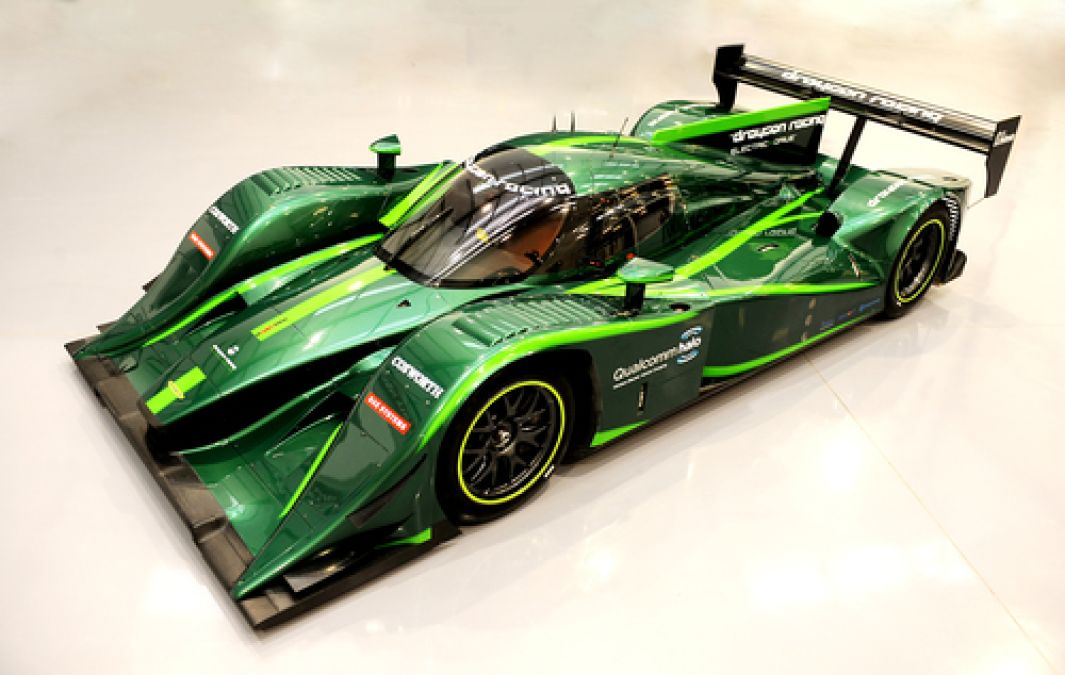How inconvenient is it really to plug in your electric car to recharge? The vendors of wireless charging systems for electric cars want us to believe plugging-in our electric car is inconvenient, and that wireless recharging is the solution. One of those vendors is Qualcomm, and at this weeks EVS26 electric vehicle symposium, the company enlisted the big green electric race car built by Drayson Racing to demonstrate the Halo wireless electric vehicle recharging system.
Drayson Racing envisions a day when race tracks will have pads embedded in the track transmitting electricity to electric race cars. This would work essentially the same as slot cars, where the track provides the electricity to run the race car. As the race car zooms around the track, it is constantly fed electricity from the road surface. The goal is to allow the race car to get by with a small battery pack, reducing costs to race teams, and enabling electric race cars to race for an hour or two just like gas powered race cars. As it stands the Lola-Drayson B12/69EV electric race car can race for approximately 15 minutes while delivering a 0-60 time of 3 seconds and a top speed of 320 kilometers/hr.
Unfortunately for Drayson Racing, at this time the Halo system can only be used by stationary vehicles. Drayson's vision of charging a race car while it's racing, well, cannot be implemented at this time. If Qualcomm and Drayson Racing can implement the vision then perhaps some day there will be a wireless electric car charging system built into every road, enabling electric cars with infinite range from electricity transmitted from the road surface.
The Qualcomm Halo wireless electric vehicle recharging system uses a pair of antenna's to transmit electricity from road surface to vehicle. One antenna is a pad embedded in the road or garage floor, which transmits electricity. The other antenna is embedded in the car, and receives electricity. The beauty of the Halo system over other wireless electric car charging systems is that it accommodates inaccurate parking, has a high efficiency rate, and can accommodate vehicles with a high ride height.
This makes it hard to envision the Halo system ever being usable with moving vehicles. How is a race car zooming by at 250 miles/hr to get an effective recharging experience from driving over a small pad? Drayson's plan is, during the 2013 electric car racing season, to use the Halo system to recharge the race car in the pit area, not on the track.
Generally speaking the concern about wireless electric vehicle charging is the potential for inefficiency. It doesn't make sense to adopt a electric vehicles to gain higher efficiencies, and then charge the battery pack with a low efficiency charging system. However, Qualcomm points out that even electric vehicle charging systems that use copper connections have efficiency losses, and that the company's Halo technology has an energy transfer efficiency comparable with wire based charging systems. In other words, Qualcomm has this potential objection covered.
Qualcomm and other wireless electric car charging system manufacturers like to play up the convenience of wireless charging. Namely, you just park your car over the charging pad, turn the car off, there's nothing to plug in, and you just walk away. Somehow one has a hard time understanding how plugging in a charging cord is inconvenient. Isn't it extremely inconvenient to have to go out of your way to find gasoline stations to refuel the gas tank? Electric cars are far more convenient than gasoline cars to begin with, because you simply plug the car in to a charging station and walk away. Yes, a wireless charging system is even more convenient than plugging a cord in, but electric car owners are already way ahead of gasoline car owners in convenience, making the extra convenience of wireless charging something like icing on the cake.
Wireless electric car charging has another not-so-obvious other benefit. Vandalism. Copper thieves frequently tear out copper wiring (some times getting electrocuted) to sell the copper as scrap. The charging cables at electric car charging stations have thick copper cable which should be enticing to copper thieves. It is a lot harder to vandalize wireless charging systems because the pad is embedded in the parking lot surface, and there is no exposed wiring.
There are no agreed industry standards for wireless electric vehicle charging systems, at this time. Qualcomm has a team dealing with regulatory certification, and are looking for compatibility with or developing appropriate standards. Obviously there is room for electromagnetic field radiation concerns just as there are for cell phones, WiFi systems and other wireless systems. Qualcomm is just as obviously well equipped to deal with these concerns due to having already faced these questions over cell phone systems.
The system is meant to be integrated into an electric car by the manufacturer, rather than added as an aftermarket option. Currently Qualcomm is conducting field trials and pilot programs, and seeking licensees to the technology. Qualcomm has been researching wireless power transfer since 1985, and is exploiting 20 years of research at the University of Auckland. Currently this is a long-term research project and it is uncertain when, or ever, we will see cars with this technology on-board.






Comments
The in-road/in-racetrack
Permalink
The in-road/in-racetrack application doesn't involve driving over a "small pad". It involves driving over an extended narrow inductive-loop, or more likely, a bed of multiple narrow inductive-loops under the road surface. This is how the road-marker lamps are operated in the Terrace Tunnel in Wellington NZ - this avoids problems which direct-connection to the wiring would suffer due to 'creep' of the road-surface which would eventually break direct-connections.